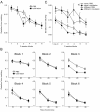Lesions of the nucleus accumbens core modulate development of matching behavior
- PMID: 24886021
- PMCID: PMC4008412
- DOI: 10.1186/1471-2202-15-55
Lesions of the nucleus accumbens core modulate development of matching behavior
Abstract
Background: The development of choice is a crucial determinant in the performance of appetitive responses. Given two options with different reinforcement rates, animals match their relative rate of responding to the relative rates of reinforcement (i.e., matching behavior). A previous study has shown that the nucleus accumbens core (AcbC) is involved in the performance of matching behavior in trained animals. However, the role of the AcbC in the acquisition of matching behavior has not been addressed.
Results: We conducted a series of experimental sessions to examine the role of the AcbC on the development of matching behavior. Instrumental responding was measured in rats with excitotoxic lesions of the AcbC. Rats were given two options that differed in the relative rate of reinforcement under concurrent variable-interval schedules. The locations of the more frequently reinforced option and the alternative option were randomly switched between sessions. Lesions of the AcbC accelerated the development of matching behavior compared to the sham-operated group. The AcbC-lesioned rats exhibited closer conformity to the matching law than shams when the options were in the same positions as in the previous session (the same condition), but not when the option locations had been switched (the different condition). The AcbC rats showed smaller probabilities of switching behavior between alternatives than shams. Post-reinforcement pausing was not affected by the AcbC lesion. Neither numbers of rewards obtained nor number of lever presses were different between the AcbC-lesioned rats and shams over session blocks.
Conclusions: Our results suggest that the AcbC plays a regulatory role in the development of matching behavior through switching probabilities rather than perception of reward magnitude. The differential effect of AcbC lesions on the matching behavior between the same and different conditions suggests influence of the spontaneous recovery, that is, reversion to a previously reinforced choice at the beginning of the next session, on the development of matching behavior in the AcbC-lesioned rats.
Figures



References
-
- Fu W-T, Anderson JR. From recurrent choice to skill learning: a reinforcement-learning model. J Exp Psychol Gen. 2006;15(2):184–206. - PubMed
-
- Kacelnik A, Bateson M. Risky theories - the effects of variance on foraging decisions. Am Zool. 1996;15(4):402–434.
-
- Schlaepfer MA, Runge MC, Sherman PW. Ecological and evolutionary traps. Trends Ecol Evol. 2002;15(10):474–480. doi: 10.1016/S0169-5347(02)02580-6. - DOI
Publication types
MeSH terms
LinkOut - more resources
Full Text Sources
Other Literature Sources

